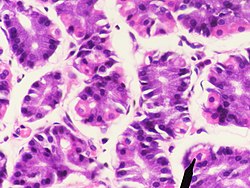Canaliculus (parietal cell)
| Parietal cell | |
|---|---|

Human parietal cells (pink staining) - stomach
|
|

Control of stomach acid
|
|
| Details | |
| Identifiers | |
| Latin | exocrinocytus parietalis |
| MeSH | Gastric+Parietal+Cells |
| Code | TH H3.04.02.1.00033 |
|
Anatomical terminology
[]
|
|
Parietal cells (also known as oxyntic or delomorphous cells), are the epithelial cells that secrete hydrochloric acid (HCl) and intrinsic factor. These cells are located in the gastric glands found in the lining of the fundus and in the body of the stomach. They contain an extensive secretory network (called canaliculi) from which the HCl is secreted by active transport into the stomach. The enzyme hydrogen potassium ATPase (H+/K+ ATPase) is unique to the parietal cells and transports the H+ against a concentration gradient of about 3 million to 1, which is the steepest ion gradient formed in the human body. Parietal cells are primarily regulated via histamine, acetylcholine and gastrin signaling from both central and local modulators (see 'Regulation').
Hydrochloric acid is formed in the following manner:
As a result of the cellular export of hydrogen ions, the gastric lumen is maintained as a highly-acidic environment. The acidity aids in digestion of food by promoting the unfolding (or denaturing) of ingested proteins. As proteins unfold, the peptide bonds linking component amino acids are exposed. Gastric HCl simultaneously activates pepsinogen, an endopeptidase that advances the digestive process by breaking the now-exposed peptide bonds, a process known as proteolysis.
Parietal cells secrete acid in response to three types of stimuli:
...
Wikipedia
